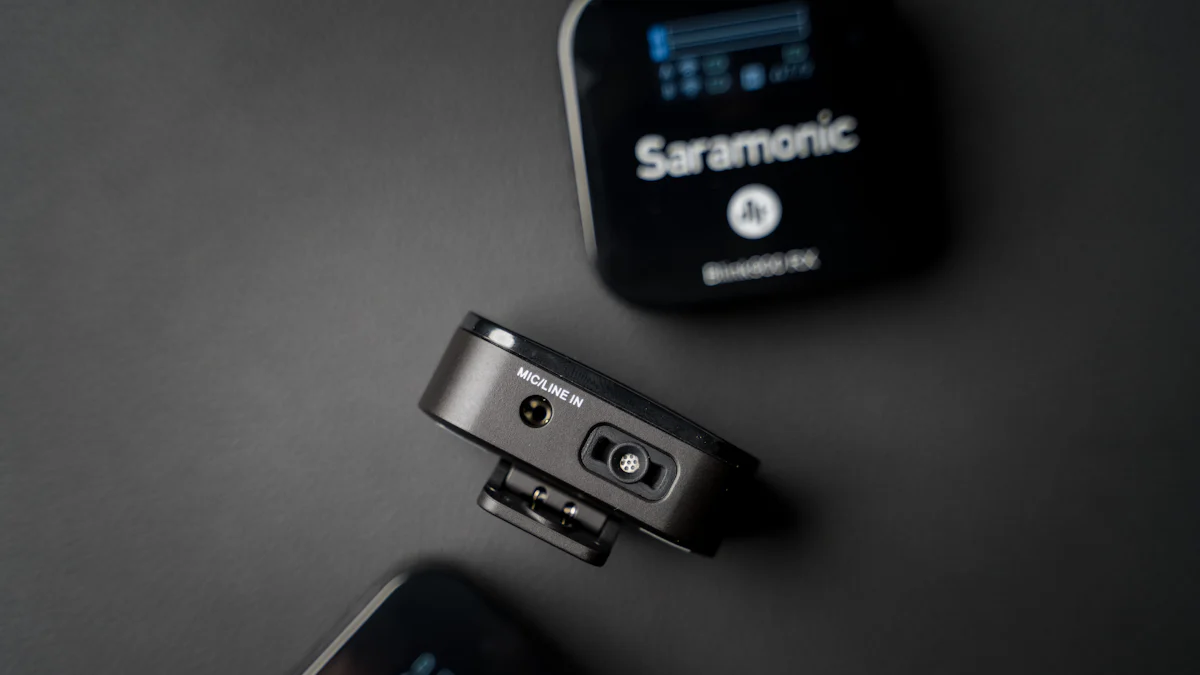Boost Your Virtual Meeting Audio with These Simple Tips

In today's world of video conferencing, audio quality plays a crucial role in ensuring effective communication during conference calls. High-quality audio enhances clarity, allowing participants to engage seamlessly. Poor sound quality can lead to misunderstandings and disrupt the flow of conversation. Zoom audio quality, for instance, prioritizes live call clarity over recordings, emphasizing the importance of real-time interaction. To improve conference call experiences, investing in the best headphones for virtual meetings can significantly reduce audio quality issues. By focusing on high-quality audio, you can enhance communication and productivity in your video calls.
Key Takeaways
- Invest in high-quality microphones, such as USB or headset options, to enhance audio clarity during virtual meetings.
- Position your microphone 6 to 12 inches from your mouth and avoid obstructions to capture clear sound.
- Create a soundproof environment by using soft furnishings and closing windows and doors to minimize background noise.
- Utilize noise-canceling software like Krisp or RTX Voice to eliminate unwanted sounds and focus on the conversation.
- Ensure a stable internet connection by using a wired setup and checking your bandwidth to prevent audio dropouts.
- Choose the right headphones, such as noise-canceling or over-the-ear headsets, to improve your listening experience and communication.
- Always test your audio setup before meetings to ensure everything is functioning correctly for clear and professional sound.
Choosing the Right Microphones

Selecting the right microphones can significantly enhance your virtual meeting experience. The type of microphone you choose will impact the clarity and quality of your audio. Here, we explore different types of microphones and provide tips on microphone placement to ensure optimal performance.
Types of Microphones
-
USB Microphones
USB microphones are popular for their ease of use and plug-and-play functionality. They connect directly to your computer, making them ideal for virtual meetings. These microphones often deliver superior sound quality compared to built-in options, providing a clear and professional audio experience. -
Headset Microphones
Headset microphones combine headphones with a microphone, offering convenience and mobility. They are excellent for reducing background noise and ensuring your voice is heard clearly. A headset with a built-in microphone can also help minimize echo during calls, making it a practical choice for busy environments. -
Built-in Microphones
Built-in microphones are found in laptops and webcams. While convenient, they often lack the sound quality of external microphones. If you rely on built-in options, consider upgrading to a better microphone for improved clarity and reduced ambient noise.
Microphone Placement Tips
-
Distance from Mouth
Position your microphone at an appropriate distance from your mouth. Too close, and you risk distortion; too far, and your voice may sound faint. Aim for a distance of about 6 to 12 inches to capture clear and balanced audio. -
Avoiding Obstructions
Ensure there are no obstructions between you and the microphone. Objects like papers or screens can block sound waves, leading to muffled audio. Keep your microphone in an open space to maintain sound clarity.
By choosing the right microphones and following these placement tips, you can significantly improve the audio quality of your virtual meetings. Whether you opt for a USB microphone, a headset, or an external microphone, the key is to ensure your setup supports clear and effective communication.
Soundproofing Your Environment
Creating a soundproof environment can greatly enhance the audio quality of your virtual meetings. By minimizing background noise, you ensure that your voice comes through clearly and without distractions. Here are some practical steps to achieve this.
Reducing Background Noise
-
Using Soft Furnishings
Soft furnishings like carpets, curtains, and cushions can absorb sound, reducing echoes and background noise. These materials work by trapping sound waves, preventing them from bouncing around the room. Research shows that fibers and porous materials can be effective sound absorbers when their thickness and density are properly controlled. Consider adding these elements to your meeting space for a quieter environment. -
Closing Windows and Doors
Close windows and doors to block out external noise. This simple action can significantly reduce the intrusion of sounds from outside, such as traffic or construction. Ensuring that your meeting space is sealed off from external disturbances helps maintain a professional atmosphere.
Creating a Dedicated Space
-
Choosing a Quiet Room
Select a room that is naturally quiet and away from high-traffic areas in your home or office. A dedicated space for virtual meetings minimizes interruptions and allows you to focus on the conversation. Look for a room with minimal electronic devices that could cause interference. -
Using Acoustic Panels
Install acoustic panels to further enhance soundproofing. These panels are designed to absorb sound and reduce reverberation. They are particularly useful in rooms with hard surfaces that reflect sound. By strategically placing acoustic panels, you can create an environment that supports clear and uninterrupted communication.
By implementing these soundproofing strategies, you can significantly improve the audio quality of your virtual meetings. A well-prepared environment not only enhances your voice clarity but also ensures a more professional and engaging meeting experience.
Using Noise-Canceling Software
In virtual meetings, software noise removal plays a crucial role in enhancing conference call audio. By using advanced technology, these applications help eliminate unwanted sounds, allowing you to focus on the conversation. Let's explore some popular options and how to configure them for optimal performance.
Popular Software Options
-
Krisp
Krisp stands out as a leading choice for software noise removal. It uses AI-based algorithms to filter out background noise, ensuring your voice remains clear. Whether you're in a bustling café or a quiet office, Krisp adapts to your surroundings, providing uninterrupted clarity. This app is compatible with various platforms, making it a versatile tool for any virtual meeting setup. -
RTX Voice
RTX Voice, developed by NVIDIA, offers another effective solution for noise cancellation. It leverages the power of NVIDIA's GPUs to remove background noise from your microphone input. This software is particularly beneficial for users with NVIDIA graphics cards, as it integrates seamlessly with their hardware. RTX Voice supports a wide range of applications, enhancing your audio experience across different platforms.
Configuring Software Settings
-
Adjusting Noise Reduction Levels
To maximize the effectiveness of your audio enhancements, adjust the noise reduction levels in your chosen software. Most applications provide sliders or settings to control the intensity of noise cancellation. Start with a moderate setting and gradually increase it until you achieve the desired clarity. This approach helps maintain a balance between eliminating background noise and preserving the natural quality of your voice. -
Testing Before Meetings
Always test your microphones and software settings before joining a virtual meeting. Conduct a quick sound check to ensure everything functions correctly. You can use tools like Audacity to record and playback your voice, allowing you to identify any issues with microphone input or software noise removal. Regular testing ensures that your audio remains clear and professional during important calls.
By incorporating noise-canceling software into your virtual meeting setup, you can significantly improve the quality of your audio. These tools help create a distraction-free environment, enabling you to communicate effectively and confidently.
Optimizing Your Internet Connection for Better Audio Quality
A stable internet connection is essential for maintaining high-quality audio during virtual meetings. By optimizing your network, you can improve conference call quality and ensure smooth communication.
Ensuring Stable Connectivity
-
Using a Wired Connection
A wired connection provides superior fidelity compared to wireless options. Ethernet cables offer consistent speeds and reduce the risk of dropouts. Unlike WiFi, which can fluctuate due to interference, a wired setup ensures a steady flow of data. This stability is crucial for maintaining high-quality audio throughout your meetings. -
Checking Bandwidth
Adequate bandwidth is vital for seamless audio transmission. Test your internet speed to ensure it meets the requirements for virtual meetings. Platforms like Zoom recommend at least 1.5 Mbps for both upload and download speeds. If your connection falls short, consider upgrading your plan or contacting your provider for assistance. Sufficient bandwidth helps improve conference call quality by preventing lags and interruptions.
Minimizing Network Interference
-
Limiting Other Devices
Reduce the number of devices connected to your network during meetings. Each device consumes bandwidth, potentially affecting your audio quality. Disconnect unnecessary gadgets or pause downloads to free up resources. By prioritizing your meeting traffic, you can enhance the clarity and reliability of your audio. -
Prioritizing Meeting Traffic
Use Quality of Service (QoS) settings on your router to prioritize meeting applications. QoS allows you to allocate more bandwidth to specific programs, ensuring they receive the necessary resources. By giving precedence to your virtual meeting software, you can improve conference call quality and maintain high-quality audio.
By optimizing your internet connection, you can significantly enhance the audio quality of your virtual meetings. A stable and interference-free network supports clear communication, allowing you to focus on the conversation without distractions.
Best Headphones for Virtual Meetings

Selecting the best headphones for virtual meetings can greatly enhance your audio experience. High-quality headphones ensure that you hear every word clearly, reducing misunderstandings and improving communication. Here, we explore two popular types of headphones that can elevate your virtual meeting experience.
Noise-Canceling Headphones
Noise-canceling headphones are a top choice for virtual meetings. They use advanced technology to block out ambient noise, allowing you to focus on the conversation. This feature is especially useful in noisy environments, such as open offices or homes with background chatter. By wearing noise-canceling headphones, you can immerse yourself in the meeting without distractions.
Benefits of Noise-Canceling Headphones:
- Enhanced Focus: By eliminating background noise, these headphones help you concentrate on the discussion.
- Improved Audio Clarity: They deliver crisp and clear sound, ensuring you catch every detail.
- Comfort: Many models offer comfortable padding, making them suitable for long meetings.
Consider investing in a pair of noise-canceling headphones if you frequently participate in virtual meetings. They provide a professional audio experience, helping you stay engaged and attentive.
Over-the-Ear Headsets
Over-the-ear headsets are another excellent option for virtual meetings. These headsets combine headphones with a built-in microphone, offering a convenient all-in-one solution. The Nuroum HP31D headset is a prime example, designed specifically for professional communication. It features advanced noise-canceling technology, a flip-to-mute feature, long battery life, and a charging stand.
Advantages of Over-the-Ear Headsets:
- Integrated Microphone: The built-in microphone ensures your voice is captured clearly, reducing the need for additional equipment.
- Noise Isolation: The over-the-ear design helps block out external sounds, allowing you to focus on the meeting.
- Versatility: These headsets are suitable for various applications, from video calls to listening to music.
When choosing the best headphones for virtual meetings, consider your specific needs and environment. Both noise-canceling headphones and over-the-ear headsets offer unique benefits that can enhance your audio experience. By selecting the right pair, you can ensure clear communication and a more productive meeting environment.
Good audio quality in virtual meetings is crucial for effective communication. It ensures that everyone understands what you say, enhancing your presence and impact. By implementing the tips discussed, you can notice significant improvements in your audio clarity. This not only benefits live interactions but also aids in creating accurate transcripts. Clear communication leads to better meeting experiences and fewer misunderstandings. Explore ways to boost your audio quality and enjoy more productive virtual meetings.
FAQ
How can I improve my audio quality on Zoom?
To enhance your sound quality on Zoom, consider investing in high-quality audio devices like an external microphone and an audio interface. Additionally, optimize Zoom's sound settings to match the devices you're using. These steps will help address audio issues and ensure clear communication during your meetings.
What type of microphone should I use for virtual meetings?
Choosing the right microphone depends on your needs and environment. USB microphones offer ease of use and superior sound quality. Headset microphones provide convenience and mobility, reducing background noise. Built-in microphones are convenient but may lack sound quality. Consider your specific requirements when selecting a microphone.
How do I reduce background noise during virtual meetings?
To minimize background noise, use soft furnishings like carpets and curtains to absorb sound. Close windows and doors to block external noise. Creating a dedicated space with minimal electronic interference also helps maintain a quiet environment.
What are the benefits of using noise-canceling software?
Noise-canceling software, such as Krisp and RTX Voice, eliminates unwanted sounds, allowing you to focus on the conversation. These applications use advanced technology to filter out background noise, ensuring your voice remains clear and uninterrupted.
How can I ensure a stable internet connection for better audio quality?
For a stable connection, use a wired setup with Ethernet cables. This reduces the risk of dropouts compared to wireless options. Check your bandwidth to ensure it meets the requirements for virtual meetings. Limiting other devices on your network can also enhance audio clarity.
What are the best headphones for virtual meetings?
Noise-canceling headphones and over-the-ear headsets are excellent choices. Noise-canceling headphones block ambient noise, enhancing focus and audio clarity. Over-the-ear headsets combine headphones with a built-in microphone, offering a convenient all-in-one solution.
Should I test my audio setup before meetings?
Yes, always test your microphones and software settings before joining a virtual meeting. Conduct a quick sound check to ensure everything functions correctly. This practice helps maintain clear and professional audio during important calls.
Can I improve audio quality with my current equipment?
Yes, you can improve audio quality by doing a system check with your existing equipment. Test your computer's default or webcam microphone before investing in a new one. Adjusting settings and placement can also enhance sound clarity.
How do acoustic panels help in soundproofing?
Acoustic panels absorb sound and reduce reverberation, making them useful in rooms with hard surfaces. By strategically placing these panels, you can create an environment that supports clear and uninterrupted communication.
Why is good audio quality important in virtual meetings?
Good audio quality ensures effective communication, reducing misunderstandings and enhancing your presence. Clear audio leads to better meeting experiences and more productive interactions. Implementing audio improvement tips can significantly boost your virtual meeting experience.
See Also
Key Strategies for Hosting Effective Video Conferences
Perfecting Your Skills for Hybrid Zoom Meetings
Add Echo Effects to Audio Online in Three Easy Steps
12 Creative Zoom Backgrounds to Enhance Virtual Gatherings
Comprehensive Guide to Mastering Computer Audio Visual Skills
